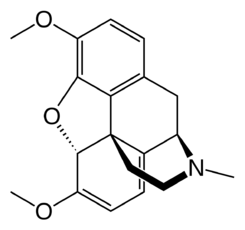Talk:Thebaine
| Thebaine | |||||||||||||||||||||||||||||||||
|---|---|---|---|---|---|---|---|---|---|---|---|---|---|---|---|---|---|---|---|---|---|---|---|---|---|---|---|---|---|---|---|---|---|
| Chemical Nomenclature | |||||||||||||||||||||||||||||||||
| Common names | Thebaine, Opium | ||||||||||||||||||||||||||||||||
| Substitutive name | Paramorphine | ||||||||||||||||||||||||||||||||
| Systematic name | 6,7,8,14-Tetradehydro-4,5α-epoxy-3,6-dimethoxy-17-methylmorphinan | ||||||||||||||||||||||||||||||||
| Class Membership | |||||||||||||||||||||||||||||||||
| Psychoactive class | Stimulant / Opioid | ||||||||||||||||||||||||||||||||
| Chemical class | Morphian | ||||||||||||||||||||||||||||||||
| Routes of Administration | |||||||||||||||||||||||||||||||||
|
|||||||||||||||||||||||||||||||||
History and culture
This History and culture section is a stub. As a result, it may contain incomplete or wrong information. You can help by expanding it. |
Chemistry
Thebaine (paramorphine), also known as codeine methyl enol ether, is an opiate alkaloid naturally occurring in opium poppies.
Pharmacology
thebaine is chemically similar to both morphine and codeine, but has stimulatory rather than depressant effects. At high doses, it causes convulsions similar to strychnine poisoning. The synthetic enantiomer (+)-thebaine does show analgesic effects apparently mediated through opioid receptors, unlike the inactive natural enantiomer (−)-thebaine.[3] While thebaine is not used therapeutically, it is the main alkaloid extracted from Papaver bracteatum (Iranian opium / Persian poppy) and can be converted industrially into a variety of compounds, including hydrocodone, Hydromorphone, Oxycodone, Oxymorphone, Nalbuphine, Naloxone, naltrexone, Buprenorphine and Etorphine. Butorphanol can also be derived from thebaine.[4]
Subjective effects
|
Physical effects 
-
- Cognitive Euphoria or Cognitive Dysphoria - Thebaine can rarely produce cognitive euphoria similar to the one of oxycodone but it happens rarely most of the time it produces no effect at all or cognitive dysphoria characterized by uncomfortable stimulantion,agitation,stomach pain and other symptoms similar to strychnine poisoning.
- Stimulation or Sedation- a predominant effect of Thebaine is central nervous system stimulation as opposed to most opiates which cause sedation and can result in an inability to sleep and restlessness, the stimulation caused by Thebaine can be described as uncomfortable rather than the euphoric stimulation caused by traditional stimulants such as Amphetamine (Adderall) or MDMA (Molly), in addition sedation is occasionally experienced during the offset of the experience as seen with substances like Morphine and Oxycodone (Oxycontin) largely due to the metabolite oripavine.
- Pain relief - Thebaine has a mild analgesic effect comparable to that of Tramadol (Ultram) though it mechanism is largely unknown.
- Wakefulness - Thebaine is often consumed alongside other opiate alkaloids in the form of Opium, so this effect is often cancelled out by the sedation caused by the Morphine and Codeine in the opium, however some poppy varieties contain high amounts of Thebaine and low Morphine and Codeine content making this effect noticeable and unpleasant for some.
- Restless leg syndrome - This effect is common even at low dosages and can make rest difficult.
- Seizure - Thebaine has been reported to cause seizures at doses above 2mg/kg in lab animals similar to strychnine poisoning.
- Hypotension - Thebaine has been reported to lower blood pressure in animal studies.
{{effects/visual| Visual effects are rarely experienced although sometimes they can occur as a result of sleep deprivation caused by the drug or as a result of the blood pressure lowering effect.
Distortions
- Double Vision
This effect is rare and usually only occurs during offset of a high dosage.
Distortions
- Distortions - this is extremely rare and can occur either as a result of sleep deprivation or hypotension, this effect is usually mild and may occur if the user stands up suddenly.
|{{effects/cognitive|
- Anxiety supression - occasionally Thebaine may suppress anxiety which is likely due to the metabolite Oripavine.
- Pain relief - Thebaine has a mild analgesic effect comparable to that of Tramadol though it mechanism is largely unknown.
Experience reports
There are currently 0 experience reports which describe the effects of this substance in our experience index.
Additional experience reports can be found here:
Toxicity and harm potential
Thebaine is very toxic and high doses produce symptoms similar to strychnine poisoning. It is strongly recommended that one use harm reduction practices when using this substance.
Lethal dosage
Tolerance and addiction potential
Thebaine is considered of low abuse potential due to its toxic effects on the body.
Dangerous interactions
 |
This dangerous interactions section is a stub. As such, it may contain incomplete or invalid information. You can help by expanding upon or correcting it. |
Warning: Many psychoactive substances that are reasonably safe to use on their own can suddenly become dangerous and even life-threatening when combined with certain other substances. The following list provides some known dangerous interactions (although it is not guaranteed to include all of them).
Always conduct independent research (e.g. Google, DuckDuckGo, PubMed) to ensure that a combination of two or more substances is safe to consume. Some of the listed interactions have been sourced from TripSit.
Legal status
Thebaine is controlled under international law, is listed as a Class A drug under the Misuse of Drugs Act 1971 in the United Kingdom, is controlled as an analog of a Schedule II drug per the Analog Act in the United States, and is controlled with its derivatives and salts, as a Schedule I substance of the Controlled Drugs and Substances Act in Canada.[5] The 2013 US Drug Enforcement Administration (DEA) aggregate manufacturing quota for thebaine (ACSCN 9333) was unchanged from the previous year at 145 metric tons.
See also
Use of this compound is not recommended due to its negative effects and toxicity.
External links
(List along order below)
- https://en.wikipedia.org/wiki/Thebaine (Wikipedia)]
- https://erowid.org/plants/poppy/poppy.shtml (Erowid Vault)
- https://pubchem.ncbi.nlm.nih.gov/compound/Thebaine (Pubchem)
